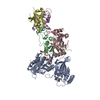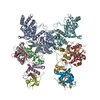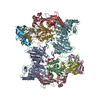+Search query
-Structure paper
| Title | The structural basis for HIV-1 Vif antagonism of human APOBEC3G. |
|---|---|
| Journal, issue, pages | Nature, Vol. 615, Issue 7953, Page 728-733, Year 2023 |
| Publish date | Feb 8, 2023 |
 Authors Authors | Yen-Li Li / Caroline A Langley / Caleigh M Azumaya / Ignacia Echeverria / Nicholas M Chesarino / Michael Emerman / Yifan Cheng / John D Gross /  |
| PubMed Abstract | The APOBEC3 (A3) proteins are host antiviral cellular proteins that hypermutate the viral genome of diverse viral families. In retroviruses, this process requires A3 packaging into viral particles. ...The APOBEC3 (A3) proteins are host antiviral cellular proteins that hypermutate the viral genome of diverse viral families. In retroviruses, this process requires A3 packaging into viral particles. The lentiviruses encode a protein, Vif, that antagonizes A3 family members by targeting them for degradation. Diversification of A3 allows host escape from Vif whereas adaptations in Vif enable cross-species transmission of primate lentiviruses. How this 'molecular arms race' plays out at the structural level is unknown. Here, we report the cryogenic electron microscopy structure of human APOBEC3G (A3G) bound to HIV-1 Vif, and the hijacked cellular proteins that promote ubiquitin-mediated proteolysis. A small surface explains the molecular arms race, including a cross-species transmission event that led to the birth of HIV-1. Unexpectedly, we find that RNA is a molecular glue for the Vif-A3G interaction, enabling Vif to repress A3G by ubiquitin-dependent and -independent mechanisms. Our results suggest a model in which Vif antagonizes A3G by intercepting it in its most dangerous form for the virus-when bound to RNA and on the pathway to packaging-to prevent viral restriction. By engaging essential surfaces required for restriction, Vif exploits a vulnerability in A3G, suggesting a general mechanism by which RNA binding helps to position key residues necessary for viral antagonism of a host antiviral gene. |
 External links External links |  Nature / Nature /  PubMed:36754086 / PubMed:36754086 /  PubMed Central PubMed Central |
| Methods | EM (single particle) |
| Resolution | 2.7 - 3.5 Å |
| Structure data | EMDB-27032, PDB-8cx0: EMDB-27033, PDB-8cx1: EMDB-27034, PDB-8cx2:  EMDB-28667: Cryo-EM map of human APOBEC3G/HIV-1 Vif/CBFbeta/ELOB/ELOC dimeric complex in State 1-prime |
| Chemicals |  ChemComp-ZN: |
| Source |
|
 Keywords Keywords |  VIRAL PROTEIN/IMMUNE SYSTEM/RNA / VIRAL PROTEIN/IMMUNE SYSTEM/RNA /  Viral protein / Viral protein /  RNA binding protein / RNA binding protein /  Complex / Ubiquitin E3 ligase / Complex / Ubiquitin E3 ligase /  VIRAL PROTEIN-IMMUNE SYSTEM-RNA complex VIRAL PROTEIN-IMMUNE SYSTEM-RNA complex |
 Movie
Movie Controller
Controller Structure viewers
Structure viewers About Yorodumi Papers
About Yorodumi Papers













